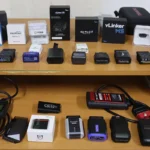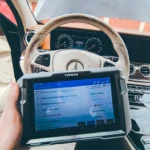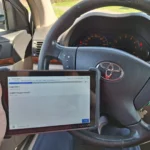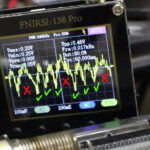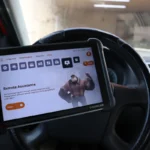The code P2138: “Accelerator Pedal Position Sensor 1-2 Correlation” indicates a discrepancy in the signals from the two sensors within the accelerator pedal assembly. This fault suggests an inconsistency in the data reported by these sensors, which could affect engine power and response.
P2138 quick overview
| Meaning | P2138: “Accelerator Pedal Position Sensor 1-2 Correlation” |
| Is it serious? | Yes, it can lead to reduced engine power or erratic vehicle behavior. |
| Possible causes | – Faulty or misaligned Accelerator Pedal Position (APP) sensor – Corroded or damaged connectors or wiring – Issues with the throttle body – Faulty or outdated Powertrain Control Module (PCM) – Water intrusion affecting electrical components |
| How to diagnose? | Perform a Wiggle Test: Check for loose connections by wiggling wires at sensors and throttle body. Inspect for Corrosion: Look for any signs of corrosion or water damage in connectors. Check Electrical Connections: Examine wiring harness and electrical connections for damage or wear. Test Sensors and Throttle Body: Use diagnostic tools to test the APP sensors and throttle body functionality. Consult Technical Service Bulletins (TSBs): Check for any manufacturer bulletins that may address common issues related to this code. |
Free PDF: How to choose OBD2 scanner

I’ve made you a free PDF to choose the OBD2 scanner in 5 minutes.





PDF is 100% free and it is designed to help you pick a scanner in less than a few minutes! Not a boring 50-page guide.
Just tell me where to send it.
How to fix P2138 – learn from mechanics
I looked into P2138 service cases at iatn.com website where in the private forums the mechanics seek advice from other mechanics. I looked up a bunch of cases to help you decide how to fix your issue and see what would a real mechanic do to solve it.
Case #1: Cadillac
Vehicle Information
- 2006 Cadillac DTS 4.6L
Issue + Repair History
- Original issue: Limp mode, check engine light, service stability system message
- Originally had code P2125 (APP sensor 2 circuit), ECM replaced
- Later code P2138 (APP sensor 1-2 correlation error), pedal assembly replaced
- Problem recurred with same symptoms and code
Suggested Fixes
- Check APP sensors 1 and 2 for resistance values
- Refer to TSBs 07-06-04-019A and 07-06-04-019 for similar issues
- Possible throttle body issue
- Inspect harness from APP to ECM for intermittent open, perform wiggle test
- Check for poor connections or water intrusion in instrument panel harness connector
Final Fix
- Issue was due to water intrusion; the problem arose after a windshield installation leading to water getting into connectors. The issue was hard to diagnose as everything felt dry until the carpet padding was lifted, which was soaking wet.
Case #2: Infiniti
Vehicle Information
- 2004 Infiniti G35 3.5L
Issue + Repair History
- Limp mode, code P2138 (accelerator pedal position sensor)
- Connector had fluid and corrosion, particularly at pin #6
- Pedal assembly replaced and relearn procedures performed, but issue persisted
Other OBD2 Codes + Test Results
- Source voltage: 5.1 volts (ok)
- Continuity between computer and APP sensor (ok)
- No short to ground or power
Suggested Fixes
- Replace the connector with a new pigtail, ensuring all corroded wires are replaced
- Check APP parameters alongside airflow PID
- Possibility of throttle body failure causing the code
Final Fix
- Replaced the corroded wire in the terminal, resolving the issue. System has been functioning properly for weeks.
Case #3: Subaru
Vehicle Information
- 2004 Subaru Legacy L 2.5L
Issue + Repair History
- Intermittent P2138 (TPS “D” and “E” rationality), limp mode
- Throttle body connector checked and cleaned, problem persisted
- Throttle body replaced, issue returned after one month
Suggested Fixes
- Compare accelerator pedal position sensor main and sub, ensure voltage sweep is correct
- Verify sensor function data with a scan tool
- Check power supply and sensor resistance, replace if out of specs
- Inspect for wiring issues or spurious signals in the harness
- Look for corrosion at connectors, especially from environmental factors
Final Fix
- Misdiagnosis initially focusing on the TPS on the throttle body
- Real issue was with the APPS (accelerator pedal position sensor)
- Replacing the pedal assembly resolved the issue.
Case #4: Chevrolet
Vehicle Information
- 2005 Chevrolet Malibu LS 3.5L
Issue + Repair History
- Codes: P0463, P0826, P1125, P2120, P2125, P2138
- Immediate recurrence of P2125 and P2138 after clearing codes
- Found LT/BLU wire open in the wiring harness
Suggested Fixes
- Consider replacing the harness instead of patching
- Be aware of potential liability issues
- Check engine wiring harness to body wiring harness
- Inspect the 8-way black connector for terminal issues or water intrusion
Final Fix
- Located broken wire at the connector behind the left front headlight
- Also found other wires near breaking point
- Repaired the broken wire, resolving the issue.
Case #5: Chevrolet
Vehicle Information
- 2008 Chevrolet Silverado 1500 LS 4.8L
Issue + Repair History
- DTC P2138 stored, reduced engine power message
- Inspected IP connector, followed DTC trouble tree
- Checked ohm reading on circuit terminals A & F (8.2 ohms)
- Considered replacing PCM
Suggested Fixes
- Perform a wiggle test at the throttle body and APP sensor
- Check for water intrusion affecting APP sensor circuits
- Inspect throttle body harness and connector
- Scope both APP signals for irregularities
- Look for any add-on equipment electrically connected to APP signals
Final Fix
- Found a variation in voltages at the APP sensor under the dash during wiggle test
- Replaced APP sensor, which resolved the problem
- Noted that Alldata’s test procedure was not accurate for this issue
How to diagnose P2138
I made you an overview of solving this DTC, based on all the advice that was suggested by certified mechanics to address this issue in previously mentioned service cases.
| Advice | Diagnostic Step Description |
|---|---|
| Perform a Wiggle Test | Check the wiring and connectors by wiggling them while monitoring voltage changes or signal disruptions to identify loose or damaged connections. |
| Inspect for Corrosion and Water Intrusion | Examine connectors, especially in areas prone to moisture, for any signs of corrosion or water damage that could affect signal integrity. |
| Replace APP Sensor or Throttle Body | If diagnostics indicate, replace the Accelerator Pedal Position (APP) sensor or the throttle body, as these are common points of failure. |
| Check Harness and Electrical Connections | Thoroughly inspect the wiring harness and electrical connections for breaks, wear, or improper connections, particularly around the throttle body and pedal assembly. |
| Use OEM Parts for Replacements | For any replacement parts, particularly sensors and wiring, use Original Equipment Manufacturer (OEM) components to ensure compatibility and reliability. |
Free PDF: How to choose OBD2 scanner

I’ve made you a free PDF to choose the OBD2 scanner in 5 minutes.





PDF is 100% free and it is designed to help you pick a scanner in less than a few minutes! Not a boring 50-page guide.
Just tell me where to send it.



